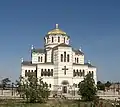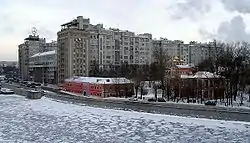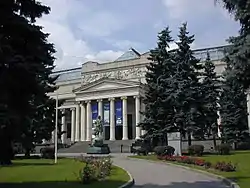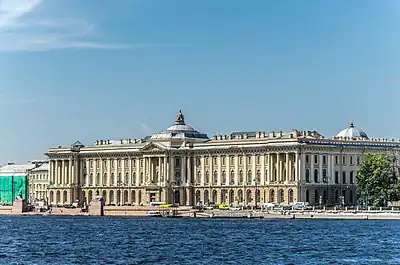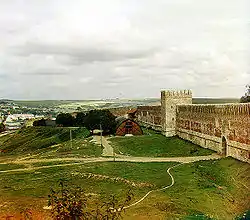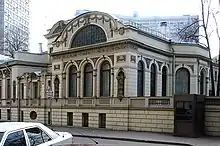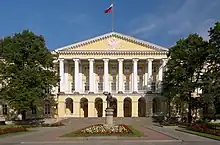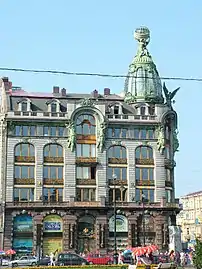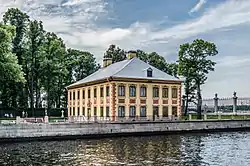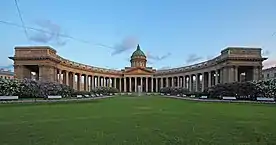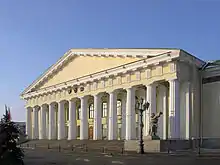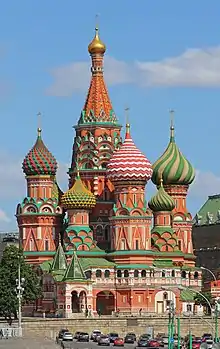List of Russian architects
This is a list of architects of the Russian Federation, Soviet Union, Russian Empire, Tsardom of Russia and Grand Duchy of Moscow, both ethnic Russians and people of other ethnicities. This list also includes those who were born in the ![]() Russian Federation/
Russian Federation/![]() Soviet Union/
Soviet Union/![]() Russian Empire/Tsardom of Russia/Grand Duchy of Moscow but later emigrated, and those who were born elsewhere but immigrated to the country and/or worked there for a significant period of time.
Russian Empire/Tsardom of Russia/Grand Duchy of Moscow but later emigrated, and those who were born elsewhere but immigrated to the country and/or worked there for a significant period of time.
Attested biographies of architects in Russian history date back to 1475, when Aristotile Fioravanti, a native of Bologna, arrived in Moscow to build the Dormition Cathedral of the Moscow Kremlin. Foreign architects had a notable place in Russian and Soviet history, especially in the last quarter of the 18th century (Charles Cameron, Bartolomeo Rastrelli, Carlo Rossi and others) and in the first quarter of the 20th century (Mies van der Roe, Erich Mendelsohn, Ernst May and others). This list includes foreign architects whose primary, and most tangible work materialized on Russian soil (i.e. Cameron, Rastrelli, Rossi) while short-term assignments by visiting architects (Mies van der Roe, Mendelsohn, May) are omitted.
Alphabetical list
A
| Portrait | Person | Notable works | ||
|---|---|---|---|---|
| Aloisio da Milano (15th–16th cc.) Grand Duchy of Moscow architect, fortification engineer |
The walls and towers of the Moscow Kremlin along the Neglinnaya River, 1495; the stone chambers, which today constitute the first three floors of the Terem Palace 1499–1508; a moat (later dubbed the Alevizov moat in his honor) along the Kremlin wall on the side of the Red Square, 1508–16. |
 | ||
| Aloisio the New (15th–16th cc.) Grand Duchy of Moscow architect |
Some sections of the Bakhchisaray palace, Crimea, before 1504; Archangel Cathedral, the burial place of Moscow's monarchs 1505–08; Cathedral of the Metropolitan Peter in Vysokopetrovsky Monastery, Moscow, admittedly the earliest rotunda in Russia 1514–17. |
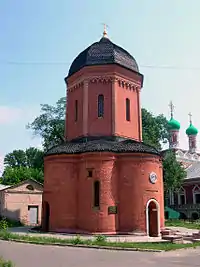 Cathedral of the Metropolitan Peter, Vysokopetrovsky Monastery |
B
| Portrait | Person | Notable works | ||
|---|---|---|---|---|
| Gavriil Baranovsky (1860–1920) eclectics and Art Nouveau architect |
Baltic Shipyard workshops (assistant to Ernest Gibert), St. Petersburg, 1880; Elisseeff Emporium, St. Petersburg, 1900–03; Buddhist Temple, St. Petersburg, 1909–15. |
|||
| Petr Baranovsky (1892–1984) architect, preservationist, restorer |
Credited with saving Saint Basil's Cathedral from destruction in the early 1930s, founding and managing the Kolomenskoye and Andrei Rublev museums, and developing modern restoration technologies; restored Golden Gate in Vladimir; restored Krutitsy Metochion in Moscow. |
 Restored Golden Gate, Vladimir |
||
_detail_01.jpg.webp) |
Vasili Bazhenov (1737–1799) neoclassical and Gothic Revival architect, graphic artist, architectural theorist and educator |
Moscow's Tsaritsyno Park buildings (first palace, Figurny Bridge, Opera House), 1775–86; Pashkov House in Moscow (attribution disputed), 1784–86. |
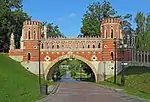 Figurny Bridge in Tsaritsyno, Moscow |
|
| Leon Benois (1856–1928) (French descent) eclectical, neoclassical, Neo-Gothic and Russian Revival architect (son of Nicholas Benois) |
Roman Catholic cathedral of Notre-Dame of Lourdes in St. Petersburg (together with Marian Peretyatkovich), 1903–09; Alexander Nevsky Cathedral, Warsaw (later demolished), 1894–1912; The House of Benua in St. Petersburg (together with Albert Benois and Yuly Benois), 1911–14. |
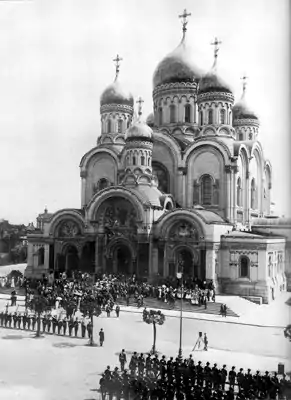 Alexander Nevsky Cathedral, Warsaw, (demolished) |
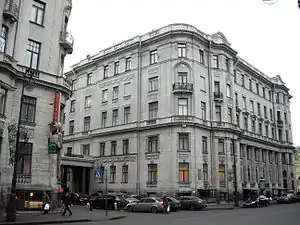 The House of Benua, St. Petersburg | |
| Nicholas Benois (1813–1898) (French descent) Gothic Revival architect (father of Leon Benois, Alexander Benois and Albert Benois) |
A court architect to Nicholas I of Russia, he oversaw many projects in the imperial residence in Petergof, notably the Principal Imperial Stables, 1847–52; rebuilt the fountain cascades of Petergof; designed the number of the first railway stations in Russia, like in Strelna, Tsarskoe Selo, and New Petergof (latter in 1857). |
 Chess mountain Cascade in Petergof |
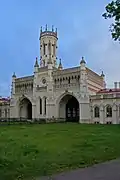 New Petergof railway station | |
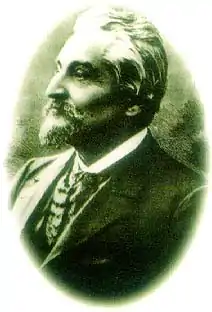 |
Alexander Bernadazzi (1831–1907) |
|||
| Karl Blank (1728–1793) |
 Church of Trinity in Serebryaniki, Moscow | |||
| Ilya Bondarenko (1867–1947) |
 Exhibition Pavilion of Abrikosov Factories (with Alexander Kaminsky) |
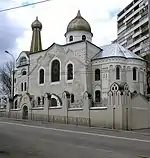 | ||
.jpg.webp) |
Joseph Bové (1784–1834) |
 Triumphal Arch in Moscow |
||
.jpg.webp) |
Vincenzo Brenna[1] (1745–1820) |
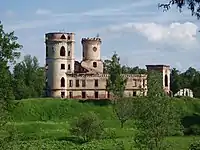 Folly Bip Fortress, Pavlovsk |
||
 |
Alexander Brullov (1798–1877) (French descent) Neoclassical architect and painter (self-portrait) |
Most of his works were created in St. Petersburg: Mikhaylovsky Theatre, 1831–33; Lutheran Church of St. Peter and St. Paul, 1833–38; Pulkovo Observatory, 1834–39; the Headquarters of Guard Corps on Palace Square, 1837–43; Pompei Hall, the Malachite Room and the White Hall in Winter Palace (after 1837). |
C
| Portrait | Person | Notable works | ||
|---|---|---|---|---|
 |
Charles Cameron[2] (1743–1812) | 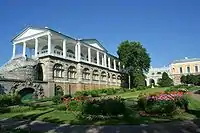 Cameron's Gallery, Tsarskoye Selo |
||
| Francesco Camporesi[1] (1747–1831)[3] | .jpg.webp) Lobanov-Rostovsky House, Moscow |
 Voskresensky Hospital, Moscow | ||
 |
Alberto Cavos (1800–1863) (Italian descent) neoclassical architect, theatre designer (the grandfather of Albert Benois, Leon Benois and Alexander Benois) |
Rebuilt the Bolshoi Kamenny Theatre in St. Petersburg, 1826–36 (mostly demolished and replaced by Saint Petersburg Conservatory); the Bolshoi Theatre in Moscow, 1853–56; completed rebuilding of the Mikhaylovsky Theatre in St. Petersburg, 1859; the Mariinsky Theatre in St. Petersburg, 1859–60. |
 Moscow's Bolshoi Theatre in Cavos times |
|
| Serge Chermayeff (1900–1996) |
D
| Portrait | Person | Notable works | ||
|---|---|---|---|---|
| Alexey Dushkin (1904–1977) |
E
| Portrait | Person | Notable works | ||
|---|---|---|---|---|
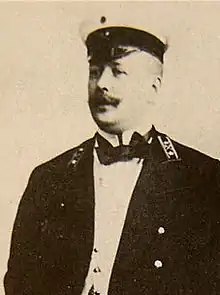 |
Mikhail Eisenstein (1867–1921) |
 Elizabetes Street 10b, Riga |
 2a at Albert Street, Riga |
F
| Portrait | Person | Notable works | ||
|---|---|---|---|---|
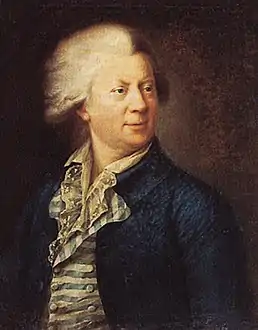 |
Yury Felten (1730–1801) (German descent) baroque, neoclassical and Gothic Revival architect, engineer |
A court architect to Catherine the Great, he created most of his works in St. Petersburg: a heavy-lifting machine that moved the enormous Thunder Stone rock, the pedestal of the Bronze Horseman, 1770; Chesme Church and Palace, 1770–80; iron-cast grille of the Summer Garden, 1783; granite embankments of Neva, 1764–84 the Old Hermitage wing of the Winter Palace, 1771–87. |
 Cast-iron grille of the Summer Garden, St. Petersburg | |
| Aristotile Fioravanti (1415–1420 – c. 1486) Grand Duchy of Moscow Renaissance architect and engineer |
Palazzo del Podestà, Bologna, Italy, 1453; Dormition Cathedral, Moscow, 1475–79. |
|||
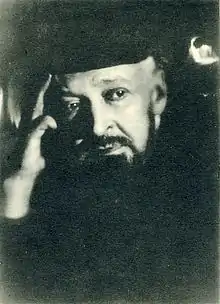 |
Ivan Fomin (1872–1936) |
G
| Portrait | Person | Notable works | ||
|---|---|---|---|---|
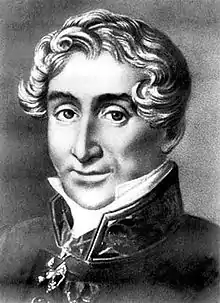 |
Domenico Gilardi (1785–1845) |
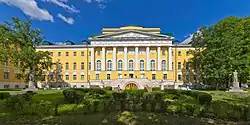 Old Building of the Moscow State University |
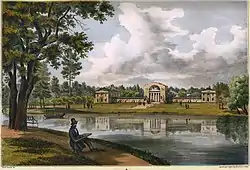 Riding Court in Kuzminki Park, Moscow | |
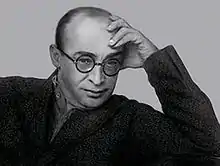 |
Moisei Ginzburg[4] (1892–1946) |
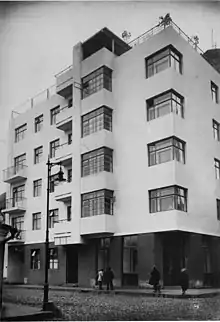 Gosstrakh Apartments, Moscow |
||
| Ilya Golosov (1883–1945) |
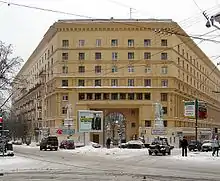 Yauzsky Boulevard 2, Moscow | |||
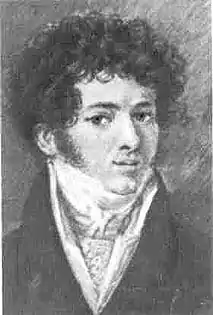 |
Afanasy Grigoriev (1782–1868) |
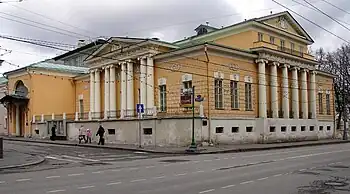 Khrushyov House, now Alexander Pushkin Museum |
 Lopukhin House, now Leo Tolstoy Museum | |
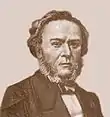 |
Alexey Gornostaev (1808–1862) |  Nikolsky Skit (Church) at the Valaam Monastery |
||
| Fyodor Gornostaev (1867–1915) |
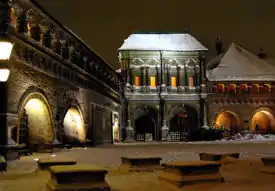 Krutitsy Metochion (restoration work) |
 Rogozhskoye Cemetery Belltower | ||
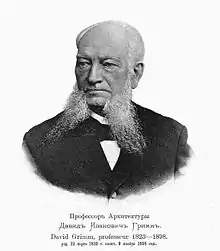 |
David Grimm (1823–1898) neo-Byzantine and Russian Revival style architect |
Grimm designed numerous Eastern Orthodox churches in Western Europe, Jerusalem and Russian Empire : Church of Maria Magdalene in Jerusalem, 1885–88; Cathedral of Saint Alexander Nevsky, Tbilisi, 1871–97 (demolished); Saint Vladimir Cathedral in Chersonesos, Crimea, 1858–97. |
H
| Portrait | Person | Notable works | ||
|---|---|---|---|---|
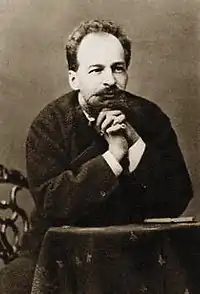 |
Viktor Hartmann (1834–1873) | 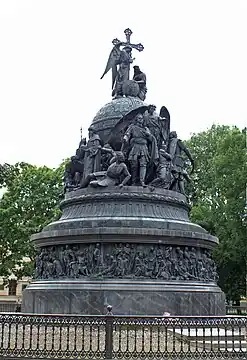 Millennium of Russia, Novgorod (architecture) |
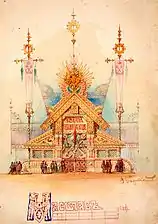 Naval section of the Russian pavilion at 1873 Wien World Fair | |
| William Heste (Hastie)[2] (1763–1832) |
 Police (Green) Bridge, St. Petersburg |
 An office building at Izhora Plants, St. Petersburg |
I
| Portrait | Person | Notable works | ||
|---|---|---|---|---|
| Boris Iofan (1891–1976) constructivist and Stalin Empire style architect |
House on Embankment, Moscow, 1928–31; 1931–33 winning draft of the Palace of Soviets (never built); Soviet Pavilions at 1937 World's Fair in Paris and 1939 World's Fair in New York City; Baumanskaya station of Moscow Metro, 1944. |
|||
 |
Illarion Ivanov-Schitz (1865–1937) |
 Lenkom Theatre Building, Moscow |
 Furmanny Lane 19, Moscow |
K
| Portrait | Person | Notable works | ||
|---|---|---|---|---|
| Alexander Kaminsky (1829–1897 |
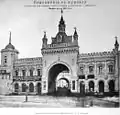 Tretyakov Drive Arch, Moscow |
 Transfiguration Cathedral at Nikolo-Ugresh monastery | ||
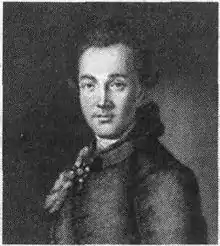 |
Matvey Kazakov (1738–1812) |
 Moscow City Hall | ||
| Lev Kekushev (1862–1919)[3] | 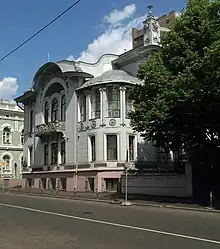 |
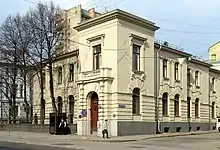 | ||
| Roman Klein (1858–1924) |
||||
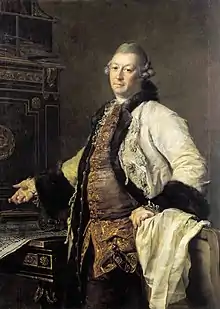 |
Alexander Kokorinov (1726–1772) |
|||
| Fyodor Kon (fl. 1585–1600) Tsardom of Russia fortification engineer and architect a monument in Smolensk Kremlin on photo |
the walls and towers of Novospassky Monastery in Moscow and several other Russian monasteries; Bely Gorod fortification ring of Moscow, 1585–93 (in 18th–19th centuries replaced with the Boulevard Ring); Smolensk Kremlin, the largest one in Russia, 1597–1602. |
 Semiverhaya (Seven-tops) tower of Moscow's Bely Gorod |
||
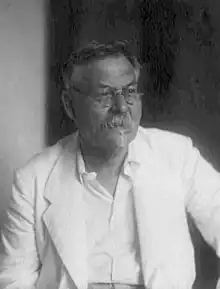 |
Ivan Kuznetsov (1867–1942) |
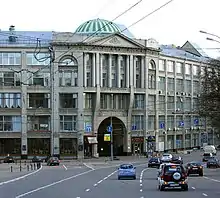 Business Yard at Varvarsky Gates, Moscow |
||
| Andrey Kvasov (1720–1770)[3] | 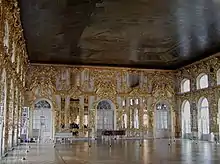 Grand Ball Hall in Catherine Palace, St. Petersburg |
 Church on Hay Square in St. Petersburg (demolished) |
L
| Portrait | Person | Notable works | ||
|---|---|---|---|---|
| Nikolai Ladovsky[4] (1881–1941) |
||||
| Nikolay Lanceray (1880–1942) |
||||
| Nikita Lazarev (1866–1932) |
||||
| Ivan Leonidov[4] (1902–1959) |
||||
| El Lissitzky[4] (1890–1941) | ||||
| Berthold Lubetkin[5] (1901–1990) |
M
| Portrait | Person | Notable works | ||
|---|---|---|---|---|
| Ivan Mashkov (1867–1945) |
||||
| Georg Johann Mattarnovy (died 1719) Tsardom of Russia Baroque architect and sculptor |
The Third Winter Palace, St. Petersburg, 1719–21; Kunstkamera, St. Petersburg, 1719–27. |
 The Third Winter Palace, St. Petersburg (demolished) |
||
| Konstantin Melnikov (1890–1974) |
||||
| Adam Menelaws (between 1748 and 1756–1831)[2] | ||||
| Miron Merzhanov (1895–1975) |
||||
| Maximilian Messmacher (1842–1906) |
||||
| Ivan Michurin (1700–1763) | ||||
| Ippolit Monighetti (1819–1878) | ||||
| Auguste de Montferrand[6] (1786–1858) |
||||
| Arkady Mordvinov (1896–1964) |
||||
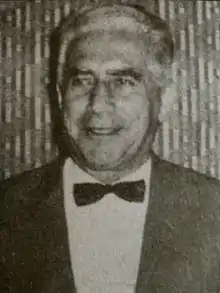 |
Nasreddin Muratkhanov (1904–1970) Russian Empire / Soviet Union An ethnic Turk, architect and civil engineer, migrated to Pakistan in 1950 |
Minar-i Pakistan (23 March 1960 – 26 July 1967) Gaddafi Stadium, Lahore |
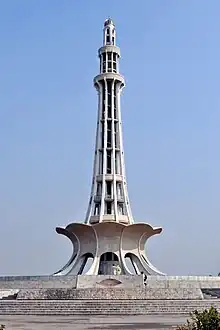 Minar-i Pakistan |
N
| Portrait | Person | Notable works | ||
|---|---|---|---|---|
| Nikolai Nikitin (1907–1973) structural designer and construction engineer |
Invented a number of innovative techniques, including the usage of prestressed concrete with wire ropes; works include: Moscow State University, 240 m, 1949–53; Warsaw Palace of Culture and Science, 237 m, 1952–55; Luzhniki Stadium in Moscow, 1955–56; The Motherland Calls statue on Mamayev Kurgan in Volgograd, 85 m, 1967; Ostankino Tower, 540 m, 1963–67; Nikitin-Travush 4000 project (4000 metres, precursor to X-Seed 4000) |
|||
| Ivan Nikolaev (1901–1979) |
||||
| Felix Novikov (1927–2022) |
O
| Portrait | Person | Notable works | ||
|---|---|---|---|---|
| Vyacheslav Oltarzhevsky (1880–1966) |
P
| Portrait | Person | Notable works | ||
|---|---|---|---|---|
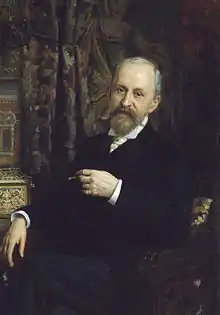 |
Alfred Parland (1842–1919) (Scottish descent) |
Church of the Resurrection of Christ in St. Petersburg | 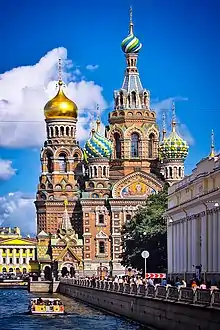 Church of the Savior on Blood, Saint Petersburg |
 Holy Resurrection Cathedral (destroyed 1968), Coastal Monastery of St. Sergius |
| Marian Peretyatkovich (1872–1916) | ||||
| Petrok Maly (? – c. 1539) Grand Duchy of Moscow |
Credited as a possible architect of the Ascension Church in Kolomenskoye (an early tented roof church), 1528–32; Kitai-gorod wall and towers (now mostly dismantled), 1533–38; Sebezh Kremlin wall (now dismantled), 1539 |
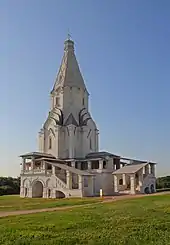 Ascension Church in Kolomenskoye, Moscow |
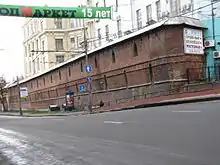 | |
| Alexander Pomerantsev (1849–1918) | ||||
| Anatoly Polyansky (1928–1993) |
Q
| Portrait | Person | Notable works | ||
|---|---|---|---|---|
| Giacomo Quarenghi[1] (1744–1817) |
R
| Portrait | Person | Notable works | ||
|---|---|---|---|---|
| Bartolomeo Rastrelli[1] (1700–1771) | ||||
| Ivan Rerberg (1869–1932) |
||||
| Antonio Rinaldi[1] (1710–1794)[3] | ||||
| Ivan Ropet (1845–1908) | ||||
| Carlo Rossi[1] (1775–1849) | ||||
| Lev Rudnev (1885–1956) Stalin Empire style architect |
Moscow State University (1949–1953); Palace of Culture and Science in Warsaw, Poland, (1952–1955); Latvian Academy of Sciences, Riga, Latvia, (1953–1956). |
 | ||
| Marco Ruffo (15th century) |
S
| Portrait | Person | Notable works | ||
|---|---|---|---|---|
| Fyodor Schechtel (1859–1926) |
||||
| Xavier Schoellkopf (1869–1911) |
Apartment buildings in Paris, e.g. 29 boulevard de Courcelles | |||
| Vladimir Shchuko (1878–1939) |
||||
| Alexey Shchusev (1873–1949) |
||||
| Vladimir Osipovich Sherwood (1832–1897) |
||||
| Vladimir Vladimirovich Sherwood (1867–1930) |
||||
| Vladimir Shukhov[7] (1853–1939) |
||||
| Pietro Antonio Solari (15th century) | ||||
| Ivan Starov (1745–1808) |
||||
| Andrei Stackenschneider (1802–1865) |
||||
| Vasily Stasov (1769–1848) | ||||
| Joseph Sunlight (1888–1978) |
||||
| Pavel Suzor (1844–1919) eclectics and Art Nouveau architect |
Over 80 apartment, baths and corporate buildings in St. Petersburg, including: Ushakov House, 1882–83; First Mutual Credit Society House, 1888–90; Singer House, 1902–04; |
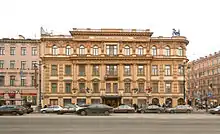 Ushakov House, St. Petersburg |
T
| Portrait | Person | Notable works | ||
|---|---|---|---|---|
| Vladimir Tatlin[4] (1885–1953) |
||||
| Konstantin Thon (1794–1881) |
||||
| Domenico Trezzini (1670–1734) Tsardom of Russia (Swiss Italian) Petrine Baroque architect |
Trezzini was the first chief architect of the newly founded Saint Petersburg; he designed the first general plan of St. Petersburg, as well as plans of Kronstadt (1704) and the Alexander Nevsky Monastery (1717), and supervised a number of major projects: Peter and Paul Fortress (since 1703), with the Peter and Paul Cathedral inside, 1712–33; Peter the Great's Summer Palace, 1710–11; Twelve Collegia Building (now the main building of Saint Petersburg University), 1722–36. |
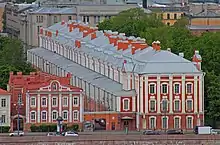 Twelve Collegia Building, St. Petersburg |
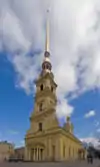 | |
| Zurab Tsereteli[8] (born 1934) |
||||
| Yevgraph Tyurin (1793–1873) |
U
| Portrait | Person | Notable works | ||
|---|---|---|---|---|
| Dmitry Ukhtomsky (1719–1774) |
V
| Portrait | Person | Notable works | ||
|---|---|---|---|---|
| Victor Vasnetsov[4] (1848–1926) |
||||
| Alexander Vesnin (1883–1959) | ||||
| Leonid Vesnin (1880–1933) |
||||
| Victor Vesnin (1882–1950) |
||||
| Aleksandr Vitberg (1787–1855) |
||||
 |
Andrey Voronikhin (1759–1814) neoclassical and Empire style architect and painter |
neoclassical interiors of Stroganov Palace, St. Petersburg, 1793; Voronikhin colonnades and Lion cascade in Petergof; Kazan Cathedral, St. Petersburg, 1801–11; Saint Petersburg Mining Institute, 1806–11. |
||
| Mikhail Vrubel[4] (1856–1910) |
Y
| Portrait | Person | Notable works | ||
|---|---|---|---|---|
| Postnik Yakovlev (16th century) Grand Duchy of Moscow Tsardom of Russia tented-roof architect and fortification engineer |
Saint Basil's Cathedral on Red Square in Moscow, 1555–60; with Ivan ShirIai designed the walls of the Kazan Kremlin and, according to some sources, the Cathedral of the Assumption in Kazan, 1561–62. |
 Kazan Kremlin wall | ||
| Vasili Yermolin (15th century) |
Z
| Portrait | Person | Notable works | ||
|---|---|---|---|---|
| Andreyan Zakharov (1761–1811) |
||||
| Alexander Zelenko (1871–1953) |
||||
| Mikhail Zemtsov (1688–1743) Tsardom of Russia Petrine Baroque architect |
participated in designing the Summer Garden in St. Petersburg and the park in Petergof; completed the design of Catherinethal palace and park in Tallinn 1718–25; The Church of Simon and Annа, Saint Petersburg, 1734; |
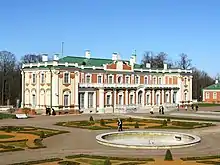 |
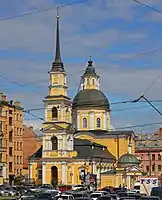 The Church of Simon and Annа, Saint Petersburg | |
| Nikolay Zherikhov (1870s–1916)[3] | ||||
| Ivan Zholtovsky (1867–1959) |
See also
Sources
Nachokina, Maria (2005). Arhitektory moskovskogo moderna ("Архитекторы московского модерна") (in Russian). Moscow: Giraffe. ISBN 978-5-89832-043-0.
References
- Citizens or natives of Italy or its predecessor states.
- Citizens or natives of the United Kingdom.
- Years of birth or death are unknown or disputed, see main article for clarifications.
- Architect known primarily for conceptual projects and graphic design.
- Émigré, worked primarily outside of Russia/USSR
- Citizens or natives of France
- Structural engineer involved in architectural projects.
- Sculptor involved in monument building projects.
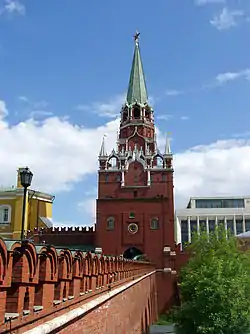
.JPG.webp)
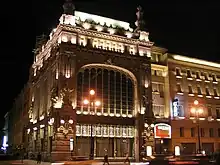

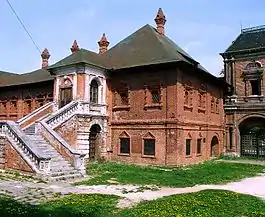

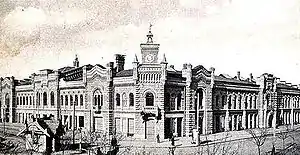
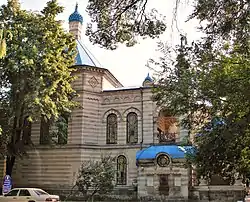



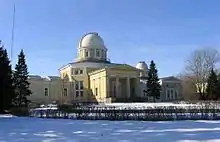



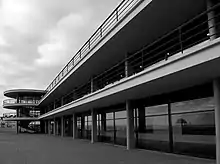
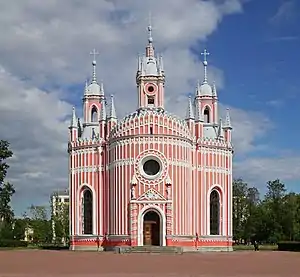
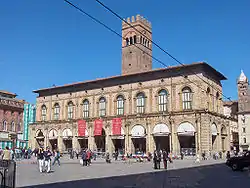
.JPG.webp)

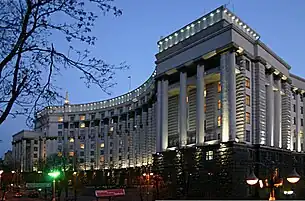
.jpg.webp)


